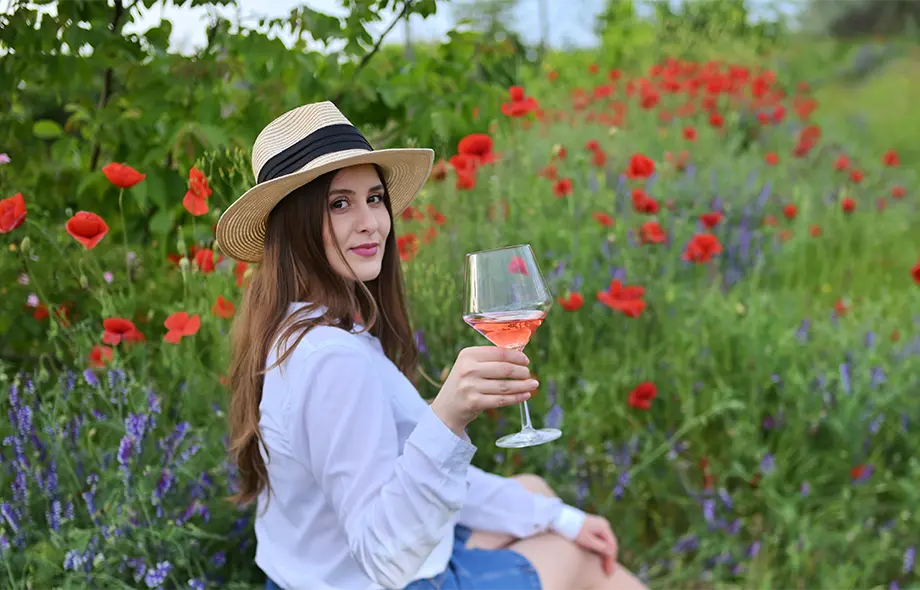Learning how to taste wine properly transforms every sip from a simple drink into a rich sensory experience. Whether you’re sampling the best wine for beginners or exploring complex vintages, mastering the fundamentals of wine tasting enhances your appreciation and helps you articulate what you enjoy about different wines.
The Three-Step Wine Tasting Method
Professional wine tasting follows a systematic approach that engages all your senses. This methodical process—sight, smell, and taste—reveals layers of information about each wine’s character, quality, and potential.
Step 1 Visual Examination Sight
Begin by examining the wine’s appearance in good lighting, preferably against a white background. Pour about two ounces into a proper wine glass—the bowl should be large enough to swirl the wine without spilling.
Look for clarity and color intensity. Red wines range from pale ruby to deep purple, while whites span from nearly clear to deep gold. The color often provides clues about the wine’s age, grape variety, and production methods. Older reds tend to develop brick or garnet hues, while older whites deepen to amber tones.
Tilt the glass at a 45-degree angle and observe the rim. A wide, watery rim in red wines might indicate lighter body, while a narrow rim suggests concentration and intensity.
Step 2 Aromatic Analysis Smell
The nose reveals approximately 80% of what we perceive as taste. Start by taking a gentle sniff without swirling—this captures the most volatile aromas. Then swirl the wine vigorously for 1015 seconds to release additional aromatics.
Stick your nose deep into the glass and take several short, sharp sniffs. Don’t worry about identifying specific aromas immediately; instead, focus on general impressions. Are the aromas fruity, floral, earthy, or spicy? Do they remind you of fresh or dried fruits? Can you detect any oak, vanilla, or mineral notes?
Common Aroma Categories
Fruit: Fresh berries, citrus, stone fruits, tropical fruits
Floral: Rose, violet, jasmine, orange blossom
Herbal/Spice: Mint, thyme, black pepper, cinnamon
Earth/Mineral: Wet stones, forest floor, mushrooms
Oak/Wood: Vanilla, toast, coconut, cedar
Step 3 Taste Evaluation
Take a moderate sip—about half a teaspoon—and let it coat your entire palate. Professional tasters often “chew” the wine, moving it around their mouth to engage all taste receptors.
Focus on these key elements:
Sweetness: Detected immediately on the tip of your tongue. Most table wines are dry, but you might perceive slight sweetness even in dry wines from ripe fruit flavors.
Acidity: Creates a mouth-watering sensation and provides freshness. High-acid wines feel crisp and bright, while low-acid wines seem flabby or flat.
Tannins (in reds): Create a drying sensation, particularly on your gums and the roof of your mouth. Tannins add structure and aging potential to red wines.
Body: The wine’s weight and fullness in your mouth. Light-bodied wines feel similar to skim milk, while full-bodied wines resemble whole milk or cream.
Finish: The flavors and sensations that linger after swallowing. Quality wines typically have longer, more complex finishes.
Common Beginner Mistakes to Avoid
Many newcomers to wine tasting make predictable errors that limit their learning experience. Rushing through the process prevents you from fully appreciating the wine’s complexity. Take your time with each step—wine tasting is meditation, not a race.
Overthinking aroma identification can create anxiety. There’s no “wrong” answer when describing what you smell. If a wine reminds you of your grandmother’s rose garden or fresh strawberries, trust your instincts. Personal associations are valid and help build your tasting vocabulary.
Another common mistake is comparing every wine to your favorites. Instead, approach each wine with curiosity and openness. Even wines you don’t particularly enjoy can teach you about your preferences and expand your palate.
Building Your Tasting Skills
Developing wine tasting proficiency requires practice and patience. Start with best affordable wines from different regions and grape varieties. This approach allows you to explore various styles without significant financial investment.
Consider keeping a wine journal to track your impressions. Note the wine’s appearance, aroma descriptors, taste characteristics, and your overall enjoyment level. Over time, patterns will emerge that help identify your preferences.
Tasting with friends enhances the experience and provides different perspectives. What one person perceives as “earthy,” another might describe as “mushroomy” or “forest-like.” These discussions expand everyone’s tasting vocabulary.
Environmental Factors
Your tasting environment significantly impacts perception. Strong odors from food, perfume, or cleaning products interfere with aroma detection. Taste wines in a neutral environment when possible. Temperature matters tremendously. Serve red wines slightly below room temperature 6065°F) and whites well-chilled 4550°F. Wines served too warm or too cold mask their true character.
Use proper glassware—it’s not just about aesthetics. Wine glasses with large bowls and narrow rims concentrate aromas and direct them to your nose more effectively than generic glasses.
Practice Makes Perfect
Remember that even professional sommeliers continue learning throughout their careers. Every wine offers something new to discover, whether it’s understanding how terroir influences flavor or recognizing the impact of different winemaking techniques.
Ready to put these techniques into practice? Purchase a few different wines from your local shop and set aside an evening for focused tasting. Start with lighter wines and progress to fuller-bodied options. Most importantly, enjoy the journey of discovery—every glass holds the potential for a new favorite.
 :
https://in.pinterest.com/vinora_official/
:
https://in.pinterest.com/vinora_official/


